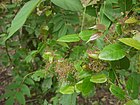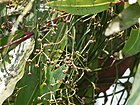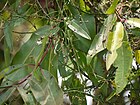Note: This is a project under development. The articles on this wiki are just being initiated and broadly incomplete. You can Help creating new pages.
Difference between revisions of "Tylophora fasciculata"
(Created page with "{{stub}} ==Uses== {{Uses|}}, {{Uses|}}, {{Uses|}}, {{Uses|}}, {{Uses|}}, {{Uses|}}, {{Uses|}}, {{Uses|}}, {{Uses|}}, {{Uses|}}, {{Uses|}}.<ref name="Uses"/> ==Parts Used== {{...") |
|||
| Line 1: | Line 1: | ||
| − | + | [[File:Tylophora dalzellii (4745807521).jpg|thumb|right]] | |
| + | '''Tylophora fasciculata''' is a small, slender, much-branched undershrub or twining pubescent herb producing stems 30 - 90cm tall. The rhizome is 25 - 50mm in diameter. The plant is sometimes gathered from the wild for local use as a medicine and rat poison. It belongs to the Asclepiadaceae family.<ref name="Plant name"/> | ||
==Uses== | ==Uses== | ||
| − | {{Uses|}}, {{Uses|}}, {{Uses| | + | {{Uses|Fever}}, {{Uses|Ulcers}}, {{Uses|Wounds}}.<ref name="Uses"/> |
==Parts Used== | ==Parts Used== | ||
| Line 7: | Line 8: | ||
==Chemical Composition== | ==Chemical Composition== | ||
| − | <ref name="chemical composition"/> | + | Tylophora indica contains 0.2%–0.3% alkaloids but the alkaloid content (w/w) in commercial samples is standardized to about 0.1% of tylophorine in the sun-dried material.<ref name="chemical composition"/> |
==Common names== | ==Common names== | ||
| Line 16: | Line 17: | ||
===Dravya=== | ===Dravya=== | ||
===Rasa=== | ===Rasa=== | ||
| − | |||
===Guna=== | ===Guna=== | ||
| Line 29: | Line 29: | ||
==Habit== | ==Habit== | ||
| − | {{Habit|}} | + | {{Habit|Climber}} |
==Identification== | ==Identification== | ||
| Line 48: | Line 48: | ||
==Mode of Propagation== | ==Mode of Propagation== | ||
| − | {{Propagation|}} | + | {{Propagation|Seeds}} |
==How to plant/cultivate== | ==How to plant/cultivate== | ||
| − | <ref name="How to plant/cultivate"/> | + | Annual rainfall of about 1000–1500 mm is ideal for Tylophora plant. It prefers partial shade conditions of the forests and soil rich in humus.<ref name="How to plant/cultivate"/> |
==Commonly seen growing in areas== | ==Commonly seen growing in areas== | ||
| − | {{Commonly seen|}}, {{Commonly seen| | + | {{Commonly seen|Thickets}}, {{Commonly seen|Hills among grass}}. |
==Photo Gallery== | ==Photo Gallery== | ||
<gallery class="left" caption="" widths="140px" heights="140px"> | <gallery class="left" caption="" widths="140px" heights="140px"> | ||
| − | + | Tylophora dalzellii (4745807521).jpg | |
| + | Tylophora dalzellii (4745965827).jpg | ||
| + | Tylophora ¿ dalzellii ? (5597304071).jpg | ||
| + | Tylophora ¿ dalzellii ? (5597885286).jpg | ||
| + | Tylophora dalzellii (4746200658).jpg | ||
</gallery> | </gallery> | ||
==References== | ==References== | ||
<references> | <references> | ||
| − | + | <ref name="chemical composition">[Chemistry]</ref> | |
| − | <ref name="chemical composition">[ | + | <ref name="Leaf">[Morphology]</ref> |
| − | + | <ref name="Plant name">Karnataka Aushadhiya Sasyagalu By Dr.Maagadi R Gurudeva, Page no:29</ref> | |
| − | <ref name="Leaf">[ | + | <ref name="How to plant/cultivate">[https://vikaspedia.in/agriculture/crop-production/package-of-practices/medicinal-and-aromatic-plants/tylophora-indica Cultivation]</ref> |
| − | |||
| − | <ref name="How to plant/cultivate">[ | ||
<ref name="Uses">Indian Medicinal Plants by C.P.Khare</ref> | <ref name="Uses">Indian Medicinal Plants by C.P.Khare</ref> | ||
</references> | </references> | ||
==External Links== | ==External Links== | ||
| − | * [ ] | + | * [https://indiabiodiversity.org/species/show/260966 Tylophora fasciculata on indiabiodiversity.org] |
| − | * [ ] | + | * [http://keralaplants.in/keralaplantsdetails.aspx?id=Tylophora_fasciculata Tylophora fasciculata on keralaplants.in] |
| − | + | ||
[[Category:Herbs]] | [[Category:Herbs]] | ||
Revision as of 16:59, 5 August 2020
Tylophora fasciculata is a small, slender, much-branched undershrub or twining pubescent herb producing stems 30 - 90cm tall. The rhizome is 25 - 50mm in diameter. The plant is sometimes gathered from the wild for local use as a medicine and rat poison. It belongs to the Asclepiadaceae family.[1]
Contents
- 1 Uses
- 2 Parts Used
- 3 Chemical Composition
- 4 Common names
- 5 Properties
- 6 Habit
- 7 Identification
- 8 List of Ayurvedic medicine in which the herb is used
- 9 Where to get the saplings
- 10 Mode of Propagation
- 11 How to plant/cultivate
- 12 Commonly seen growing in areas
- 13 Photo Gallery
- 14 References
- 15 External Links
Uses
Parts Used
[[:Category:Herbs with used in medicine|]], stem, leaves, Root.
Chemical Composition
Tylophora indica contains 0.2%–0.3% alkaloids but the alkaloid content (w/w) in commercial samples is standardized to about 0.1% of tylophorine in the sun-dried material.[3]
Common names
| Language | Common name |
|---|---|
| Kannada | |
| Hindi | |
| Malayalam | |
| Tamil | |
| Telugu | |
| Marathi | |
| Gujarathi | |
| Punjabi | |
| Kashmiri | |
| Sanskrit | |
| English |
Properties
Reference: Dravya - Substance, Rasa - Taste, Guna - Qualities, Veerya - Potency, Vipaka - Post-digesion effect, Karma - Pharmacological activity, Prabhava - Therepeutics.
Dravya
Rasa
Guna
Veerya
Vipaka
Karma
Prabhava
Habit
Identification
Leaf
| Kind | Shape | Feature |
|---|---|---|
Flower
| Type | Size | Color and composition | Stamen | More information |
|---|---|---|---|---|
| {{{5}}} |
Fruit
| Type | Size | Mass | Appearance | Seeds | More information |
|---|---|---|---|---|---|
Other features
List of Ayurvedic medicine in which the herb is used
Where to get the saplings
Mode of Propagation
How to plant/cultivate
Annual rainfall of about 1000–1500 mm is ideal for Tylophora plant. It prefers partial shade conditions of the forests and soil rich in humus.[5]
Commonly seen growing in areas
Photo Gallery
References
External Links
- Ayurvedic Herbs known to be helpful to treat Fever
- Ayurvedic Herbs known to be helpful to treat Ulcers
- Ayurvedic Herbs known to be helpful to treat Wounds
- Herbs with used in medicine
- Herbs with stem used in medicine
- Herbs with leaves used in medicine
- Herbs with Root used in medicine
- Habit - Climber
- Index of Plants which can be propagated by Seeds
- Herbs that are commonly seen in the region of Thickets
- Herbs that are commonly seen in the region of Hills among grass
- Herbs





